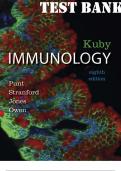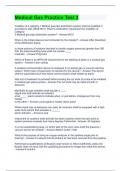1
, (Kuby Immunology Covid-19 Digital Update, 8e Jenni Punt, Sharon Stranford, Patricia Jones, Judy Owe
(Test Bank Latest Edition 2023-24, Grade A+, 100% Verified)
Chapter 01
1. Two of the main, early theories proposed to explain how antigen-specific antibodies develop were the
instructional theory and the selective theory. How did the two differ? Which was ultimately shown to be
CORRECT?
ANSWER: The selective theory says that, when an antigen receptor binds with an antigen, the cell becomes
activated (or the cell is selected to proliferate and secrete more copies of the receptor). The
instructional theory says that the antigen receptor molds itself to the antigen. The selective theory
was shown to be correct.
2. Often, serendipity plays a role in significant scientific discoveries. In your own words, explain how
serendipity led Pasteur to discover a cholera vaccine.
ANSWER: Pasteur developed the vaccine in chickens, which were in short supply. He challenged groups of
chickens with cholera bacteria—some of which were previously exposed to an attenuated version of
cholera bacteria. Only the previously exposed animals were protected from a new challenge, which
led to the use of weakened pathogens as vaccines.
3. Despite its having been eradicated on a global scale, smallpox is presently considered a potential bioterrorism
threat. Why? Use evidence to support your answer.
ANSWER: After eradication was achieved, smallpox vaccination programs largely ended. As populations
continued to grow over time, an ever-increasing percentage of the human population remains
unvaccinated and thus, is still susceptible to the disease.
4. Prior to 1999, it was claimed that a thimerosal additive in vaccines was contributing to the rising incidence of
autism. If the claims were true, what resultant trend might you expect to observe in the rate of autism once
thimerosal was removed from vaccines?
ANSWER: One would reasonably expect a decrease in the rate of autism. However, cases of autism continued
to rise after thimerosal was removed from vaccines in 2001.
5. Given the discovery and development of effective antibiotics, make an argument for the continued use of
vaccines against bacterial pathogens. Use evidence to support your answer.
ANSWER: Antibiotics are used for treatment of disease, not typically for prevention. Antibiotic treatment is not
foolproof (considering the rising incidence of antibiotic resistance). Vaccines are a preventative
measure, and prevention is the gold standard for infectious disease control measures.
6. You have a friend unfamiliar with immunology, and he asks you the following question: "Why do I need the
flu shot every year, but don't need an annual chickenpox vaccine?" As a student of immunology, how would
you explain this discrepancy to your friend? Use evidence to support your answer.
ANSWER: The virus that causes the flu changes every year - as a result, a new flu vaccine must be prepared
each year based on a predication of the most common forms of the virus likely to be encountered.
Vaccines are specific in the type of pathogen against which they protect, and protection against one
type does not guarantee protection against pathogens that are closely-related.
7. Provide one benefit and one drawback of generating random recognition receptors during the development of
B cells.
ANSWER: A benefit is having the capacity to recognize and respond to diverse pathogens as they evolve. A
drawback is that some recognition receptors could potentially recognize and target host antigens. 2
Copyright Macmillan Learning. Powered by Cognero. Page 1
,Name: Class: Date:
Chapter 01
8. A portion of our immune systems' white blood cells is constantly circulating throughout the body via
circulation and lymphatics. What is the benefit of such circulation?
ANSWER: The circulation of the white blood cells allows for a more comprehensive surveillance of the body
for the presence of potential pathogens. A significant portion of the human body is constantly
exposed to potential microbial pathogens.
9. Complete the following table by comparing and contrasting innate and adaptive immune responses.
Innate Adaptive
Immunity Immunity
Is mediated by what cells?
What do they recognize?
How are the receptors
encoded?
Why can't they control all
infections alone?
What do they do in
response to antigen?
ANSWER: Adaptive
Innate Immunity
Immunity
Macrophages, NK
Is mediated by T cells and B
cells, neutrophils,
what cells? cells
mast cells eosinophils
What do they Specific
Pathogen patterns
recognize? epitopes
How are the
Rearranged
receptors Germ line
gene segments
encoded?
Why can't they
Pathogens evolve Takes too long
control all
escape mechanisms to develop
infections alone?
What do they do Produce
Engulf and destroy,
in response to antibodies, kill
induce inflammation
antigen? infected cells
10. What are the hallmarks of inflammation? Describe the physical characteristics of someone experiencing an
inflammatory response.
ANSWER: Redness, swelling, heat, pain. Someone experiencing inflammation might have localized swelling
and redness or itching or may be experiencing faintness due to a lowering of blood pressure if more
severe.
3
11. Upon receiving immune serum as a treatment for a venomous snake bite, would the recipient be immune
Copyright Macmillan Learning. Powered by Cognero. Page 2
, Name: Class: Date:
Chapter 01
from future bites of the same species?
ANSWER: In the short-term, probably, as the serum contains protective antibodies against the venom. In the
long-term, no, as serum treatment is a form of passive immunity. Passive immunity does not
generate long-lived memory cells.
12. Provide one common feature of and two differences between B-cell receptors and PRRs.
ANSWER: A common feature is that they both are used to recognize foreign antigens. A B-cell receptor is more
selective than a PRR. The DNA that encodes for a PRR in an individual is inherited. The DNA that
encodes for a mature B-cell receptor from an individual is not passed on to offspring.
13. Given that an important function of the immune system is to both recognize and dispose of cancerous cells,
postulate why tumors can be established in a human host.
ANSWER: There are two primary reasons. First, cancerous cells are self-originating, thus self-tolerance
mechanisms can inhibit the development of an effective immune response. Second, as is common
with some pathogens, genetic variability within a population of cancer cells gives them an
advantage in terms of evading the immune response.
14. The hygiene hypothesis posits that there is a connection between environmental conditions and certain
inappropriate immune responses. If you were a supporter of the hygiene hypothesis, what recommendations
would you make to keep people healthier?
ANSWER: Expose children to more common antigens found in dirt and in the outdoors. Reduce use of
antimicrobials.
15. Which is the BEST definition of "immunity"?
a. The state of having been exposed to a pathogen repeatedly
b. The state of being resistant to reinfection with a pathogen
c. When an individual has never been exposed to a pathogen
d. When the immune system is activated
e. When physical barriers are not enough to prevent infection
ANSWER: b
16. What happens to a pathogen as it becomes attenuated?
a. It becomes more dangerous to the host.
b. It gets smaller.
c. It has weakened virulence.
d. It becomes older.
e. All of the answers are correct.
ANSWER: c
17. Which of the following advances can be credited to progress made in our understanding of immunology?
a. Smallpox eradication
b. Treatment of asthma
c. Ability to transplant human organs 4
Copyright Macmillan Learning. Powered by Cognero. Page 3





